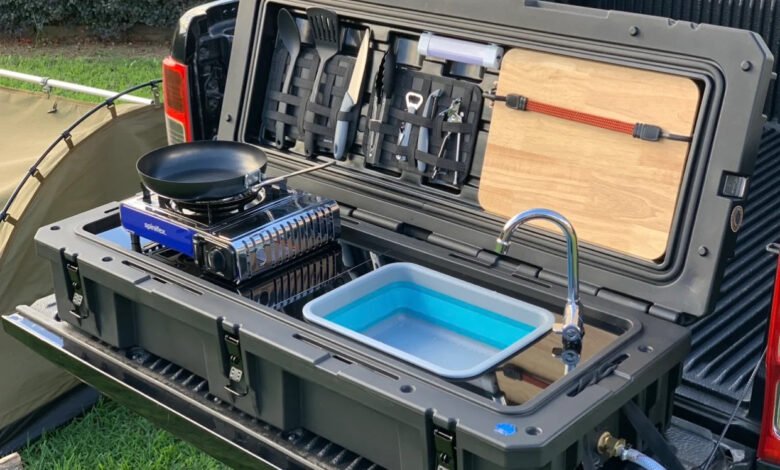Portable Kiosks: The Ultimate Guide to Mobile Business Solutions

Introduction
Running a business requires finding innovative ways to connect with customers wherever they are. Traditional storefronts limit your reach to a single location, but what if you could bring your services directly to your audience? Portable ki osks offer exactly this opportunity.
These mobile business solutions are transforming how companies engage with customers, from retail pop-ups at music festivals to information stations at corporate events. Unlike fixed installations, portable kiosks provide the flexibility to adapt your business presence based on location, season, or special events.
This guide explores everything you need to know about portable kiosks, including their key benefits, industry applications, essential features, and real-world success stories. By the end, you’ll understand how these versatile tools can expand your business reach and create new revenue opportunities.
What Are Portable Kiosks?
Portable kiosks are self-contained, mobile structures designed to provide products, services, or information in various locations. These units can be easily transported and set up quickly, making them ideal for temporary installations or businesses that need to move between different venues.
The design varies significantly based on intended use. Some portable kiosks are compact tablet stands perfect for trade shows, while others are full-sized retail units complete with payment processing, inventory storage, and climate control. What unites them all is their mobility and self-sufficient operation.
Modern portable kiosks often incorporate digital technology, including touchscreen interfaces, wireless connectivity, and integrated payment systems. This technology integration allows businesses to offer sophisticated services while maintaining the flexibility to relocate as needed.
Key Benefits of Portable Kiosks
Cost-Effective Market Entry
Starting a traditional brick-and-mortar business requires significant upfront investment in rent, utilities, and long-term lease commitments. Portable kiosks eliminate many of these costs by allowing businesses to test markets without permanent commitments.
The initial investment for a portable kiosk is typically much lower than establishing a physical storefront. Operational costs remain minimal since these units don’t require ongoing rent payments or utility connections in most cases.
Maximum Mobility and Flexibility
The primary advantage of portable kiosks is their ability to go where customers are, rather than waiting for customers to come to you. This mobility opens up opportunities to participate in seasonal events, festivals, conferences, and temporary installations.
Weather conditions or poor foot traffic at one location don’t spell disaster when you can simply pack up and move to a better spot. This flexibility allows businesses to optimize their presence based on real-time conditions and opportunities.
Enhanced Customer Engagement
Portable kiosks create unique touchpoints for customer interaction. Their temporary nature often generates curiosity and foot traffic, as people are naturally drawn to new or different installations in familiar spaces.
The self-service nature of many portable kiosks also appeals to customers who prefer quick, efficient interactions without waiting for staff assistance. This autonomy can improve customer satisfaction while reducing operational overhead.
Extended Market Reach
Rather than serving only customers within a specific geographic radius, portable kiosks allow businesses to tap into multiple market segments across different locations. A food vendor, for example, can serve downtown office workers during lunch hours and event attendees on weekends.
This expanded reach often translates directly into increased revenue opportunities without the proportional increase in fixed costs associated with multiple permanent locations.
Industries Leveraging Portable Kiosks
Retail and E-commerce
Online retailers use portable kiosks to create physical touchpoints for their digital brands. These installations allow customers to interact with products before purchasing, bridging the gap between online and offline shopping experiences.
Clothing brands often deploy portable kiosks at college campuses, shopping centers, and events to showcase new collections and process orders for items not kept in stock on-site.
Food and Beverage
The food service industry has embraced portable kiosks extensively, from coffee carts in office buildings to gourmet food trucks at festivals. These mobile units allow restaurants to expand their customer base without opening additional permanent locations.
Beverage companies frequently use portable kiosks for product sampling and sales at sporting events, concerts, and outdoor gatherings where traditional vending might be impractical.
Healthcare and Wellness
Healthcare providers deploy portable kiosks for health screenings, vaccination campaigns, and wellness education. These units can be positioned in community centers, schools, and workplace environments to increase healthcare accessibility.
Mental health organizations use portable information kiosks to provide resources and screening tools in locations where people might feel more comfortable seeking initial support than in traditional clinical settings.
Technology and Telecommunications
Tech companies use portable kiosks to demonstrate new products, provide technical support, and process service upgrades. These installations are particularly common at airports, universities, and shopping centers.
Wireless carriers frequently deploy portable kiosks in high-traffic areas to capture customers who might not visit traditional retail stores but are interested in learning about new plans or devices.
Financial Services
Banks and credit unions use portable kiosks to extend their reach into underserved communities or provide services at events where traditional banking might be needed. These units can process account openings, loan applications, and basic transactions.
Financial technology companies deploy portable kiosks to introduce new payment systems, cryptocurrency services, or investment platforms to potential users in accessible, non-intimidating environments.
Essential Features to Consider
Structural Design and Durability
The physical construction of your portable kiosk must withstand transportation, weather exposure, and frequent setup and breakdown. Look for materials that balance durability with weight considerations, as heavier units become more difficult and expensive to transport.
Weather resistance is crucial for outdoor applications. Even if your kiosk will primarily operate indoors, it may need to endure outdoor transport and temporary exposure during setup.
Technology Integration
Modern consumers expect digital interaction capabilities. Consider incorporating touchscreen interfaces, wireless internet connectivity, and mobile payment processing to meet these expectations.
Battery life and power management become critical considerations for locations without reliable electrical access. Solar panels or extended battery systems can provide independence from grid power.
Security Features
Portable kiosks face unique security challenges since they can’t rely on building security systems. Built-in locking mechanisms, tamper-resistant designs, and remote monitoring capabilities help protect both the equipment and any inventory or cash stored inside.
Consider GPS tracking systems for high-value units, as their portable nature makes them potential theft targets.
User Experience Design
The interface design should be intuitive enough for users to navigate without extensive instructions or staff assistance. Large, clear displays and simple navigation paths reduce user frustration and increase successful interactions.
Accessibility features ensure your kiosk can serve customers with varying abilities and technical comfort levels.
Real-World Success Stories
A specialty coffee roaster expanded from one permanent location to five portable kiosks positioned throughout their metropolitan area. By analyzing foot traffic patterns and adjusting locations seasonally, they increased revenue by 340% while keeping operational costs minimal.
The key to their success was data-driven location optimization. They tracked sales performance at different sites and times, gradually building a rotation schedule that maximized exposure to their target demographic.
A healthcare nonprofit deployed portable wellness screening kiosks in underserved rural communities. Over 18 months, these units provided health assessments to over 12,000 residents who previously had limited access to preventive care.
Their success stemmed from community partnership development. Rather than simply positioning kiosks randomly, they worked with local organizations to identify optimal locations and times when community members would be most receptive to health services.
A tech startup used portable kiosks to demonstrate their new software platform at industry conferences and trade shows. This strategy generated leads that converted to sales at twice the rate of traditional booth presentations.
Their approach focused on hands-on interaction rather than passive demonstration. Conference attendees could actually use the software through the kiosk interface, creating deeper engagement than typical sales presentations.
Planning Your Portable Kiosk Strategy
Success with portable kiosks requires strategic planning beyond simply purchasing equipment. Start by identifying your target locations and understanding the logistics of operating in each space.
Research permit requirements, as many locations require authorization for temporary commercial installations. Build relationships with property managers, event organizers, and local officials who can facilitate your operations.
Consider seasonal patterns and local events that might impact foot traffic. A kiosk strategy that works well during summer festivals might need adjustment for winter months or different community calendars.
Develop systems for tracking performance across different locations and time periods. This data becomes invaluable for optimizing your deployment strategy and maximizing return on investment.



